No.550 Sqn Avro Lancaster NF998 BQ-D Crash Landing – 24th February 1945
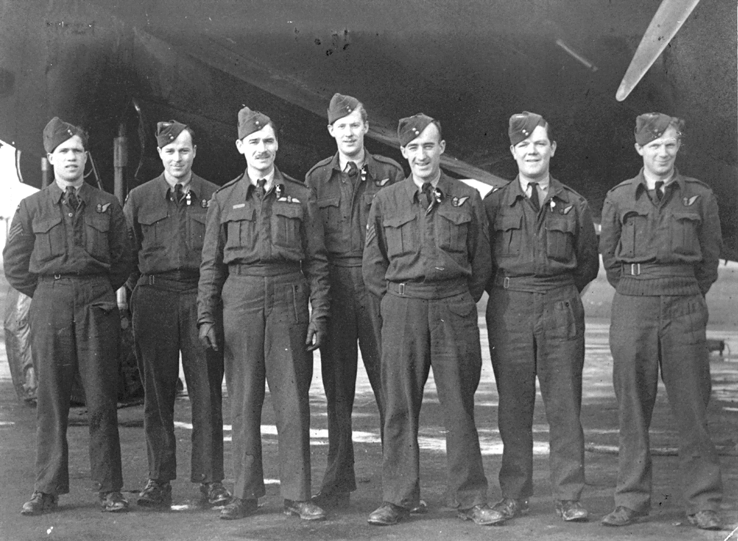
Crew of Lancaster NF988 or ME428 (unconfirmed). Left to right: Sgt Hicks, Sgt Ditson, F/O Harris, Sgt Smith, Sgt Yemen, Sgt Keller, F/O Nichol. Used with permission from 550 Squadron and RAF North Killingholme Association. Names with the exception of F/O Harris are currently unconfirmed.
No.550 Sqn Lancaster I NF998 BQ-D crewed by Sgt. Melvin Tomas “Tom” Ditson RCAF (R.285781) – Mid Upper Air Gunner, F/O Robert Douglas Harris RCAF (J.37989) – Pilot, Sgt. Douglas James Hicks RCAF ( R.2858) – Rear Gunner, Sgt. G.P. Kelleher RAF (1836271) – Wireless Operator, F/O Gordon James Nicol RCAF (J.41228) – Air Bomber, Sgt Kenneth John Boucher Smith RAF (1881097) – Flight Engineer and F/Sgt. David Johnston Yemen RCAF (R.206017) – Navigator took off from North Killingholme at 1558hrs on 23rd February 1945 for a mission over Pforzheim, one of 367 Lancasters in the mission.
Fifteen seconds after they had bombed their target at 2008hrs from 8,000 feet, the aircraft lurched violently to the left and started in a downward spiral. From the rear gunner position, Sgt Hicks saw sparks and flames streaming past his turret, his intercom went dead and the hydraulic power to the turret was cut. He then spotted trace bullets arcing behind the aircraft and returned fire in their direction, but didn’t see their source. Sgt Hicks contemplated bailing out with the aircraft seemingly out of control, but thought better of jumping into the fires of Pforzheim below him.
Suddenly the aircraft righted and seemed to be back under control. Although a fighter had indeed fired on them, their predicament was down to flying into the bomb load of another Lancaster. They had been struck by some sixty 4lb incendiaries.
In the cockpit, pilot F/O Harris had a fire warning from No.1 engine and had feathered it – that engine had supplied the hydraulic power to the rear turret. After the loss of that engine, the aircraft wanted to turn left, so the pilot and engineer lashed the rudder pedals fully right. They were not to know then the damage that had been caused to the controls.
In the mid-upper turret, one incendiary had smashed through the perspex and fractured the shoulder of Sgt Ditson, who fell to the floor in agony.
Other incendiaries hit the tail-plane, both main-planes, rudders and others fell inside the fuselage but most failed to ignite.
After they unsuccessfully tried to find Juvincourt airfield, F/O Harris requested a course be set for Manston with its long and wide runway, and the Lancaster’s IFF (Identification, Friend or Foe) was set to emergency.
They landed at Manston at 0020hrs on the 24th February, with what was initially a smooth landing which saw the crew begin celebrating their relief of surviving. However, the aircraft’s left main tyre blew and the aircraft veered off the runway to the left. They hit a line of concrete sewer pipes that were about to be installed along the side of the runway which collapsed the undercarriage which was promptly flung up through the wing, causing the aircraft to come to an abrupt halt.
All the crew managed to scramble out, were debriefed, had breakfast and then went to bed. Sgt Ditson, however, was taken to hospital. Later, they all took a ride back to the aircraft and counted over sixty holes in the aircraft, some that were just an inch away from piercing the fuel tanks. Some it would seem had made their way all the way through the aircraft, and one had caused the damage to the left rudder. They also saw the ten incendiaries still embedded in the aircraft that had not ignited.
F/O Harris expected their squadron would send an aircraft to collect them, but instead they were given vouchers and the bus timetable.
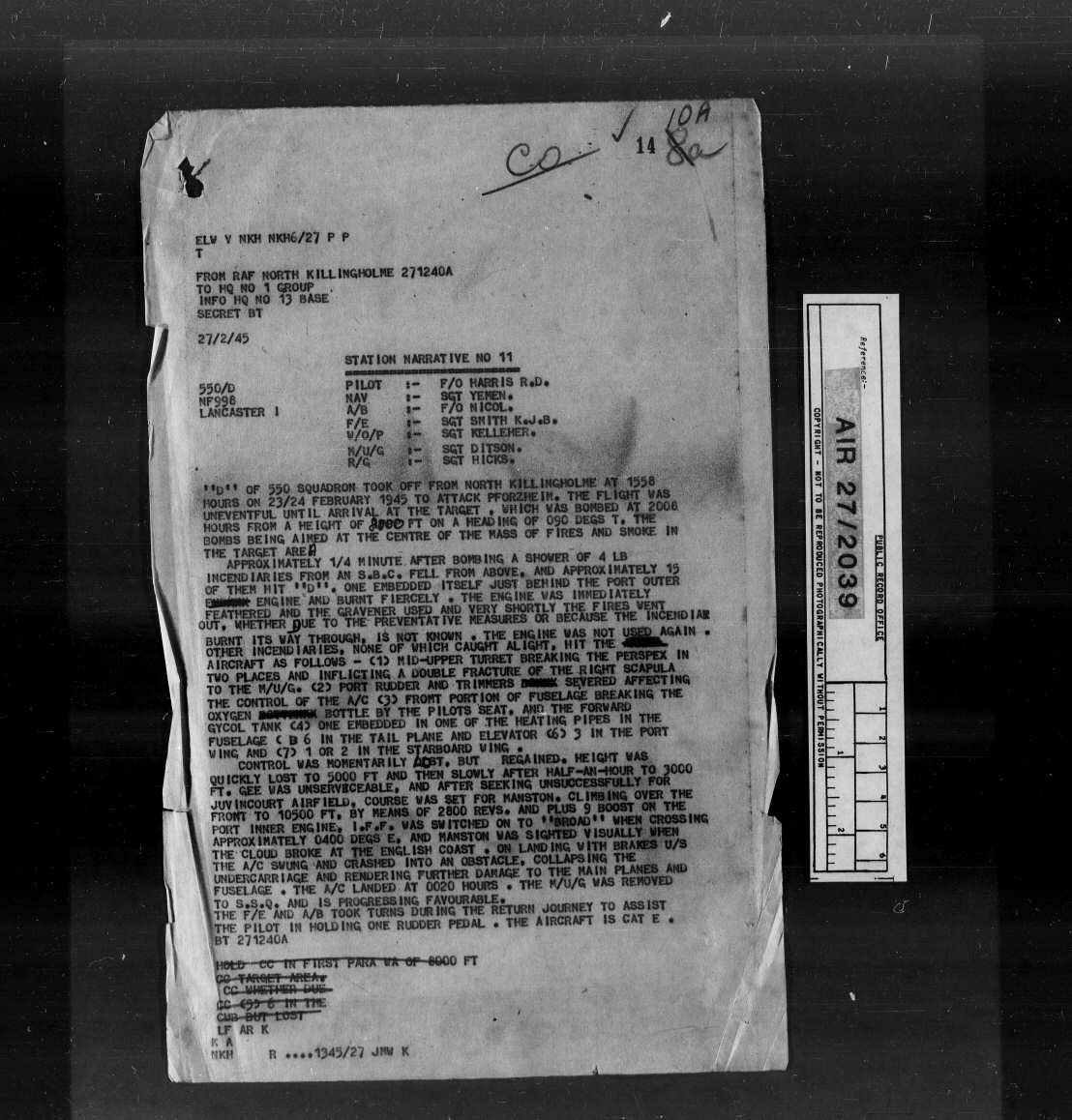
Station Narrative No. 11 – 550 Sqn. used with permission from 550 Squadron and RAF North Killingholme Association.
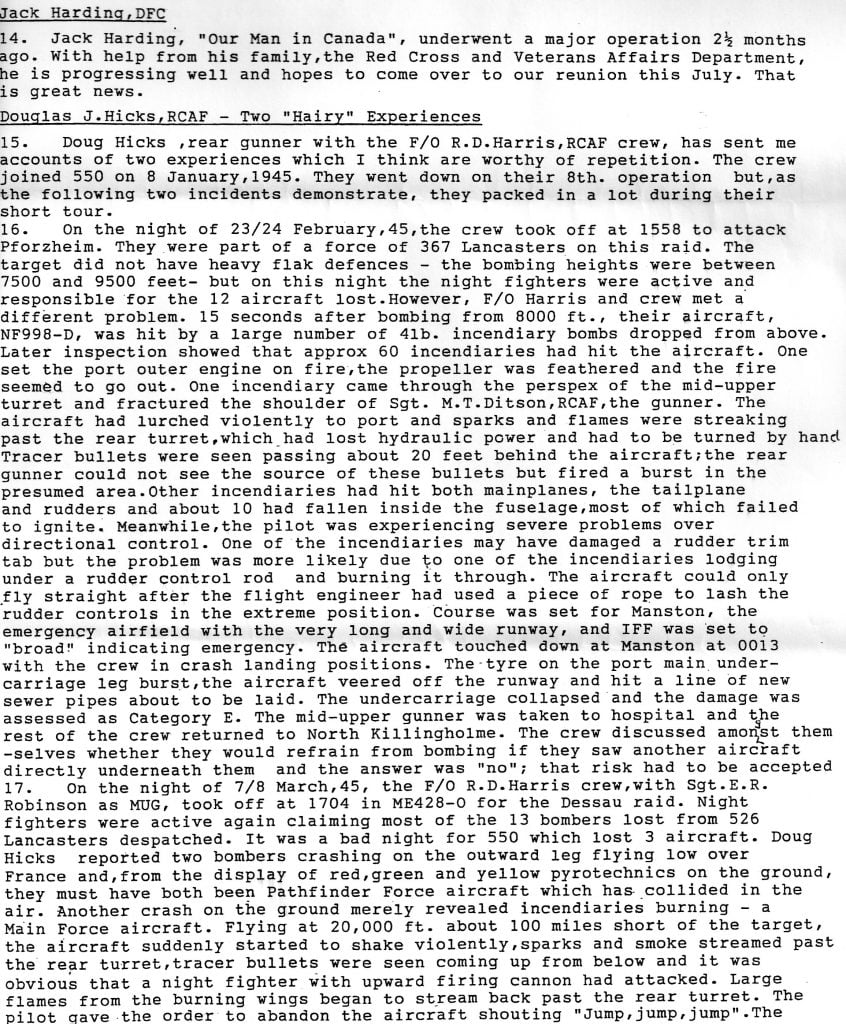
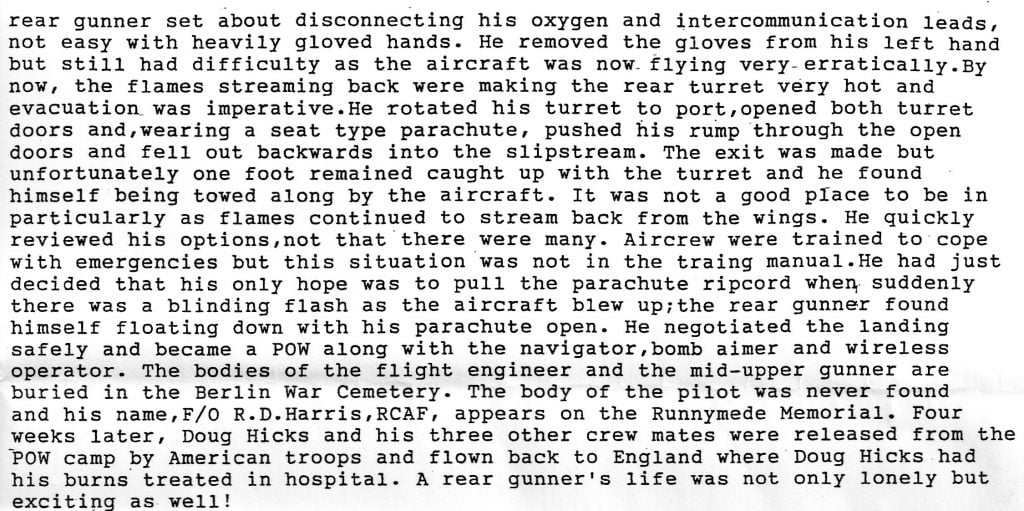
“Hairy Experiences”, accounts of two experiences by Douglas Hicks (Air Gunner)
Courtesy of Jack Harris. Used with permission from 550 Squadron and RAF North Killingholme Association.
Later on 7/8 March 1945 whilst on a mission to Dessau in Lancaster ME428/BQ-O, F/O Harris, Sgt Smith along with Sgt E.R. Robinson were killed; F/Sgt Yemen, F/O Nicol, Sgt Kelleher and Sgt Hicks were taken POW after parachuting from the burning aircraft, but were released from the POW camp four weeks later by American troops. It was the crew’s eight trip in ME248. The body of F/O Harris was never found but is commemorated on the Ruddymede Memorial, the other two are buried in the Berlin War Cemetery. Some evidence suggests they were attacked by a night fighter, Heinz-Wolfgang Schnaufer – the highest scoring night fighter ace, with 121 victories. Other reports suggest the aircraft was hit by flak and exploded as crew were preparing to abandon the aircraft and those that managed to survive were blown out.
You can read more about this second raid here:
http://www.550squadronassociation.org.uk/documents/public/Lancasters-Crews/FORDHarris/index.php
It would seem that after he was injured in the operations of 24th February, Sgt Ditson had been replaced because of his injuries, but at present no further record can be found for him.
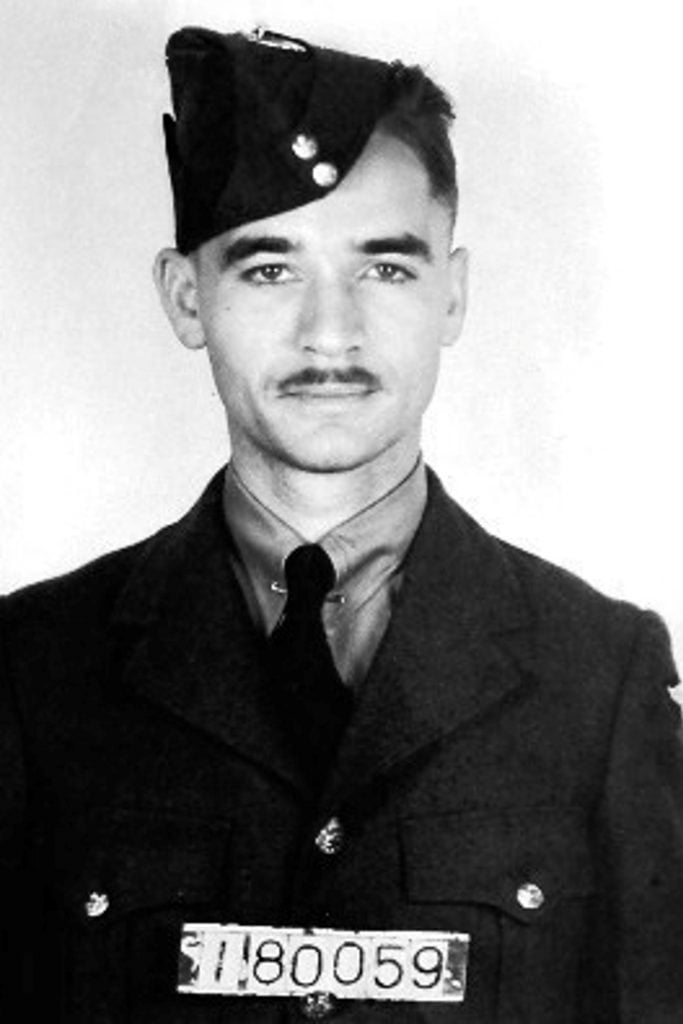
F/O Robert Douglas Harris RCAF of No.550 Sqn, pilot of Lancaster NF988. Used with permission from 550 Squadron and RAF North Killingholme Association.
Sources:
- Aircrew Remembered.
- Some details and photos used are with permission from 550 Squadron and RAF North Killingholme Association (http://www.550squadronassociation.org.uk) Image(s) © 550 Squadron and RAF North Killingholme Association. http://www.550squadronassociation.org.uk/documents/public/Lancasters-Crews/FORDHarris/index.php
- The Commonwealth Air Training Plan Museum: http://www.airmuseum.ca/
Last Updated:


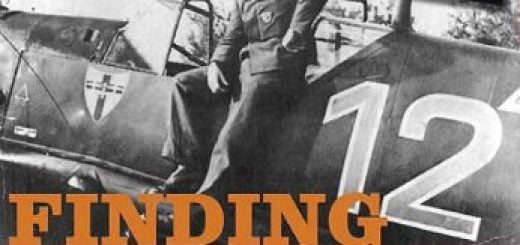

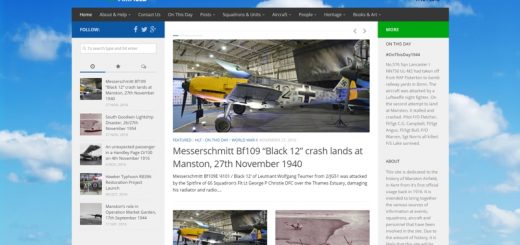




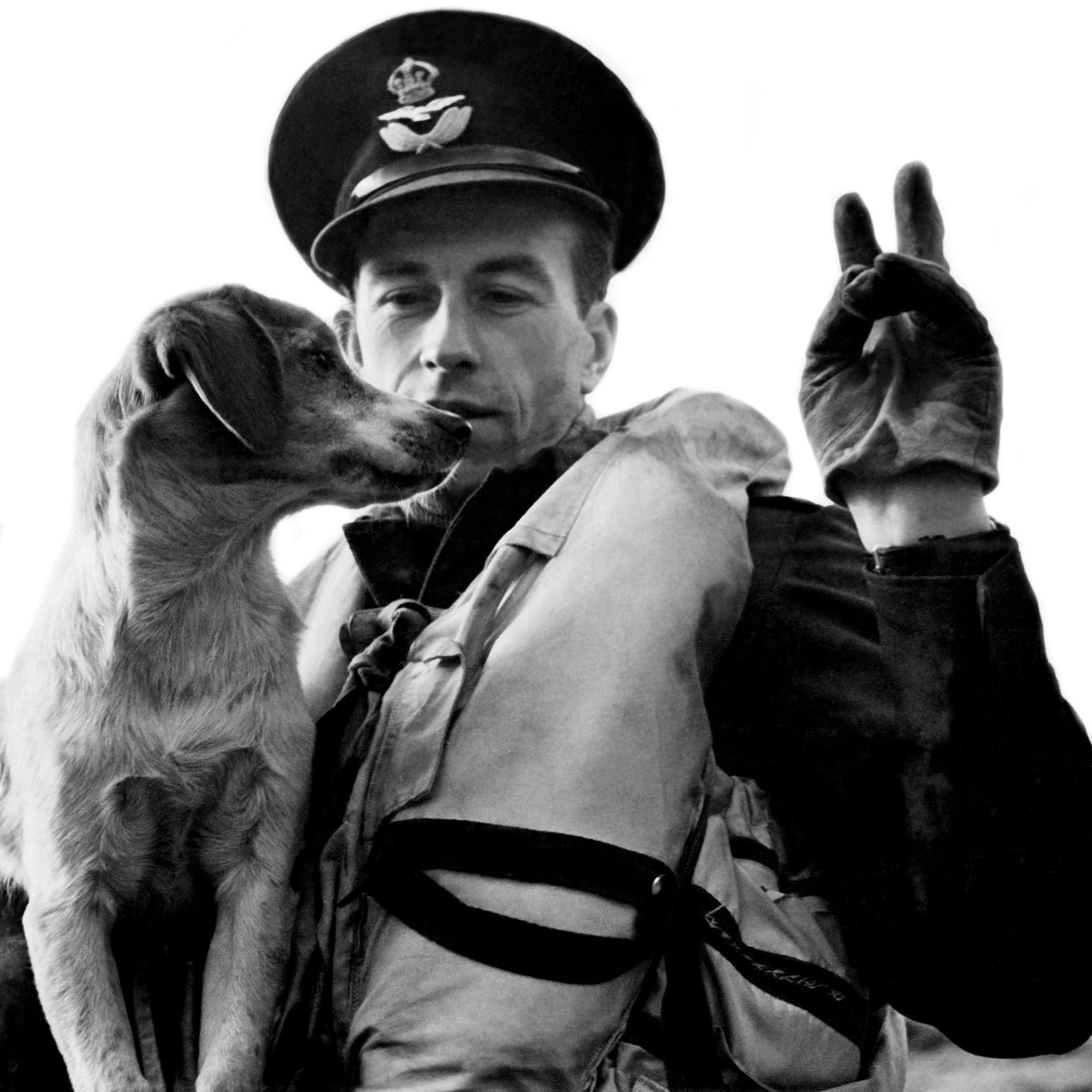
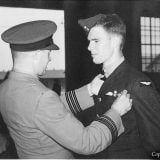


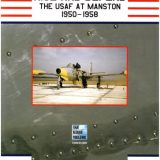
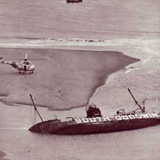
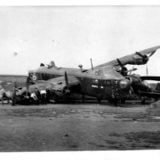
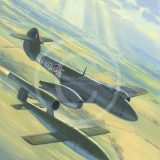
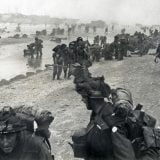
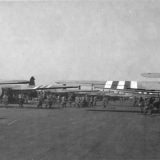
I have a feeling that the crashed Lancaster was still visible at Manston well into the 1950s. Can anyone confirm please?